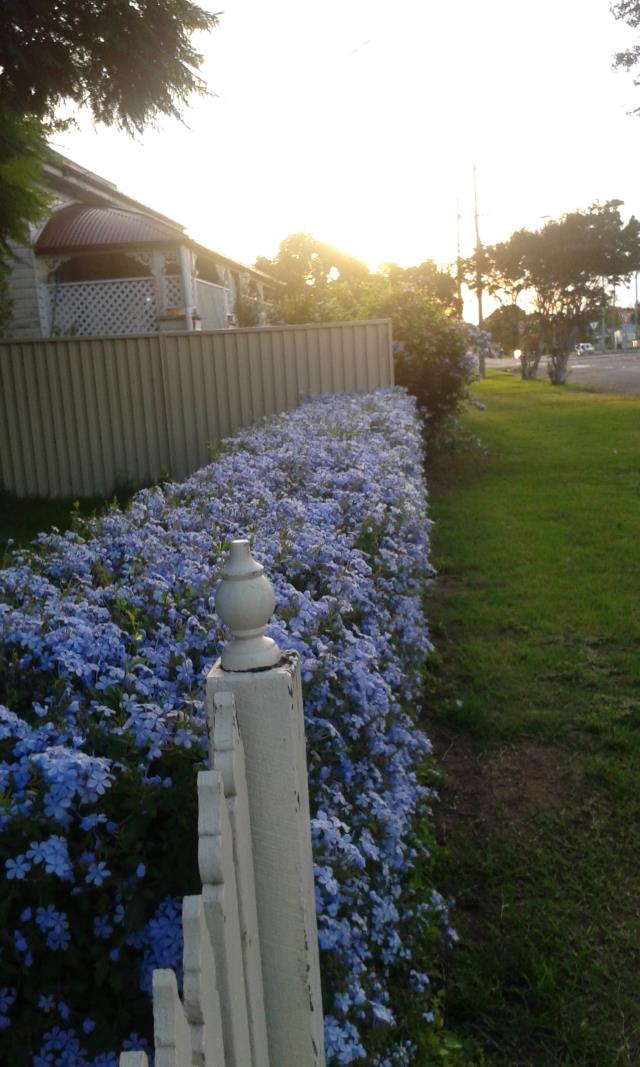By Beatrice Hawkins
While driving down Percy Street recently I saw an amazing sight.
I was so taken I turned around, went back and, with the owner’s permission, took a photo.
It was a beautiful, neatly clipped, blue Plumbago hedge in full flower. This is an old fashioned favourite that is easy to grow and deserves a spot in a garden if you have the room.
I have enjoyed seeing white varieties and various shades of blue as I have been about in town.
Now that I’ve done a little research, it seems it is an ideal plant for many situations.
It is native to Southern America, South Africa and Southern Asia.
It can be grown as a shrub, a climber, espaliered against a wall or, as in the Percy Street situation, a wonderful clipped hedge.
It can be grown in poor soil, on a sloping bank, in full sun or part shade and is drought tolerant once established.
It doesn’t need pruning but if you clip off the spent flowers or give it a light trim, it will flower prolifically again on new growth.
It has very few, if any, pests and diseases.
It flowers from about November but its peak flowering time is February/March.
It comes in various shades from white through pale blue to a dark blue which looks spectacular.
It can be propagated from cuttings in summer or by seed.
At this time of the year Michaelmas Daisies – or Easter Daisies as they are known in the southern hemisphere – are an appropriate flower to think about. They are also an old-fashioned favourite that is rarely seen these days which is a shame.
They are a many branched perennial with masses of small daisy flowers in colours from white through lilac to blue, pink, purple and deep purple/red.
They like full sun to part shade in a rich soil that is water retentive. They die down in the winter and this is the time to cut them right back to almost ground level and when they start to shoot again in spring, mulch them with well rotted manure or compost that has added nutrients.
Divide the clumps every two or three years as over-crowding will cause them to produce less flowers.
They were introduced to Britain from North America in 1710 and bloomed there around the time of St Michael’s Day in September, so that is how they got their common name, but bloom around Easter here, hence Easter Daisies.
They come in tall growing varieties best planted at the back of a garden bed and now in a dwarf form that doesn’t require staking. Another thing I’d like to have in a garden.
Hence I am once again enlarging a flower bed!
Now for some trivia:
– The daisy got its name because of its yellow centre.. the “day’s eye” because of its likeness to the sun.
– Scientists tell us that there are over 270,000 species of flowers that have been documented and are existing in the 21st century.
– The foxglove was named in the mistaken belief that foxes used them as gloves to deaden their footsteps when hunting.
– The spice saffron comes from a certain type of crocus flower. Each bulb will only produce one flower and each flower only produces three red stigmas that are the highly prized and expensive, saffron threads.
– Hairgrass and pearlwort are plants that grow in Antarctica.
– The rose was adopted as the national flower of England at the time of the War of the Roses (1455-1485) between the House of Lancaster (red rose) and the House of York (white rose).
Don’t forget the Queensland Garden Expo in Nambour and the Horticultural Society’s bus trip on 8 July. Be assured of a fun and informative day out.
*This is an old article that has been digitised so our readers have access to our full catalogue.







